How to Reupholster a Bench – a DIY for Beginners
This post may contain affiliate links which means I make a commission if you shop through my links.
Disclosure Policy
I am a somewhat crafty person … until I am not. So, I really had no idea how to reupholster a bench when this particular project entered my radar.

My parents had an old, and very neglected bench in their basement, which they have had since the 1960’s. It may even be older than that.
But it was still sturdy and a little nostalgic – so I thought …
Why not? It’s probably not that hard to reupholster a bench, right?
More DIY Home Decor Projects You Might Like
In the end, I can say that I am happy with the way that it turned out. Definitely not bad for a first time upholstery DIY. But I’m not sure that I would do it again.
These are the steps that I took to turn my bench from this:
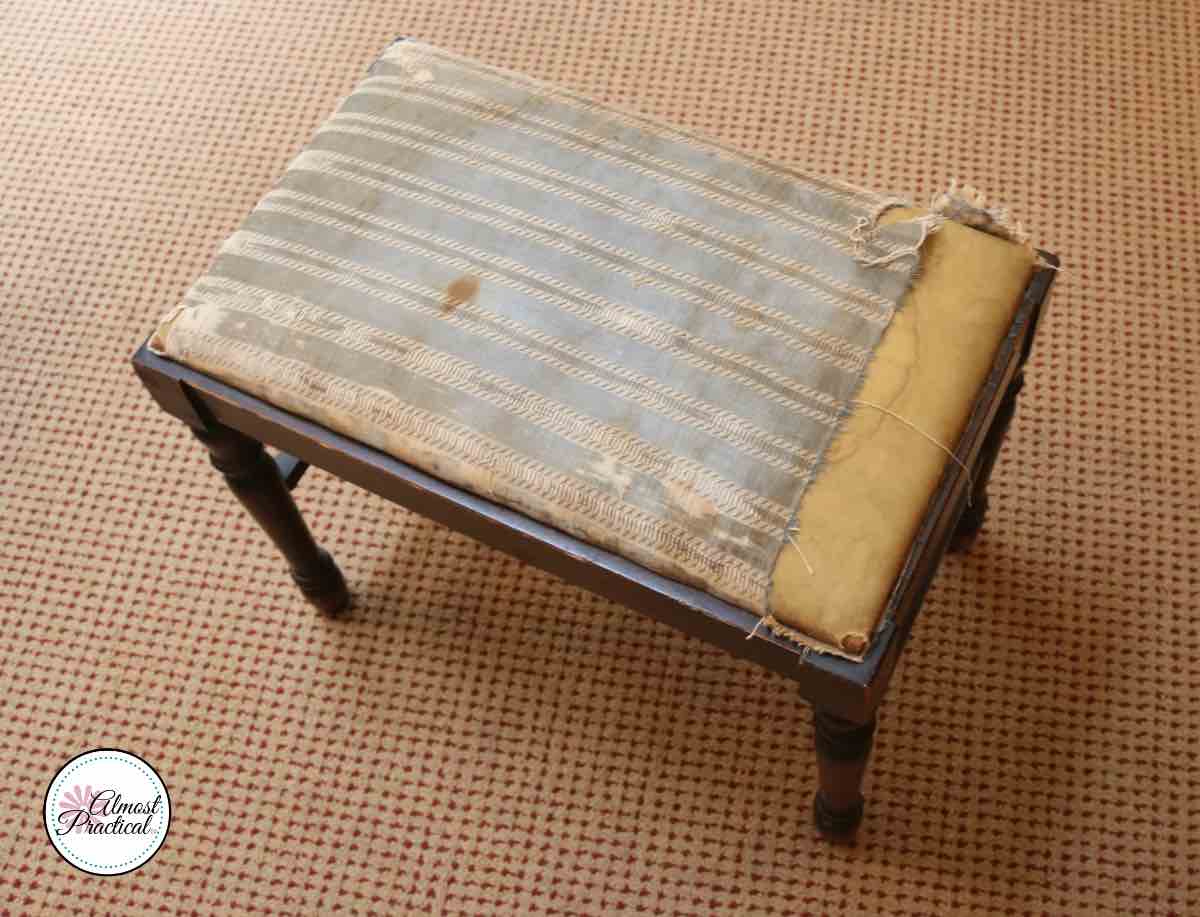
into this:
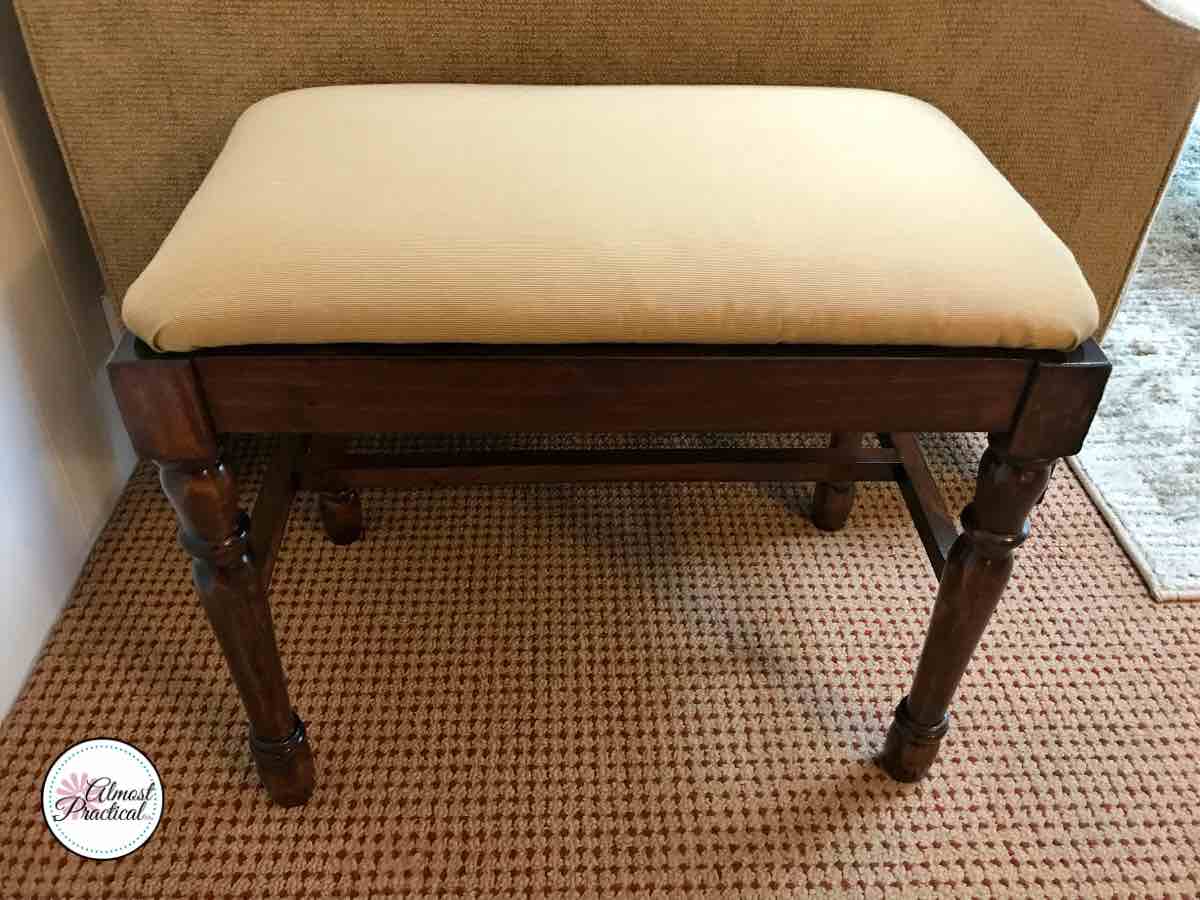
Gather Your Supplies
If your plan is to reupholster a bench, then you will need the following supplies.
For this project, I refinished the wooden base. If you plan to paint your base, then your supplies list will be slightly different.
For the Base
- Formby’s Furnisher Refinisher
- Super Fine Steel Wool – 0000
- Refinishing Gloves
- Sandpaper
- Minwax Stain (I used Red Mahogany for this bench)
- Minwax Polyurethane in clear gloss
- Foam brushes
- Rags
For the Cushion
- Upholstery foam – I used a 1 inch, high density, firm foam to reupholster this bench
- Upholstery batting – bonded Dacron
- Electric staple gun
- T50 Staples
- Protective goggles
- Upholstery Fabric of your choice – Magnolia Home has some gorgeous upholstery fabrics that you can buy by the yard on Amazon.
Remove the Bench Cushion
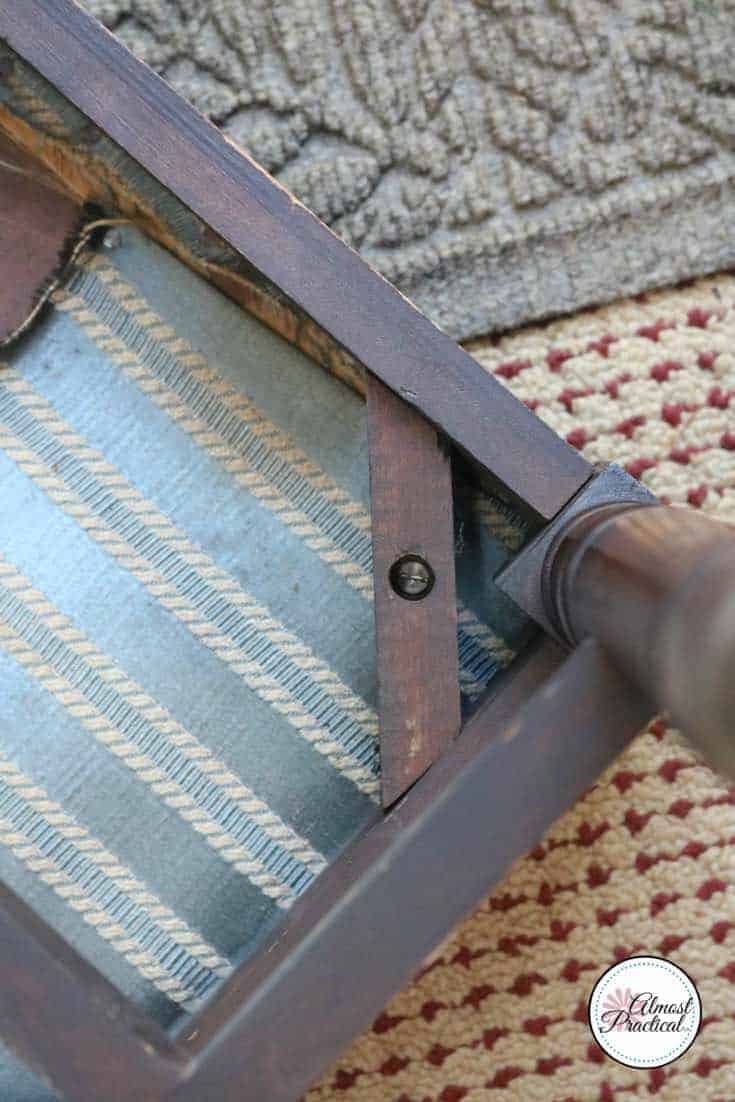
The first thing that I did was remove the seat cushion by turning the bench over and using a screwdriver to remove the four screws that attached the base to the seat.
I then removed the tacks that held the old fabric and cushion to the base board.
Also, there were sliders attached to all four bench legs, so I removed these too.
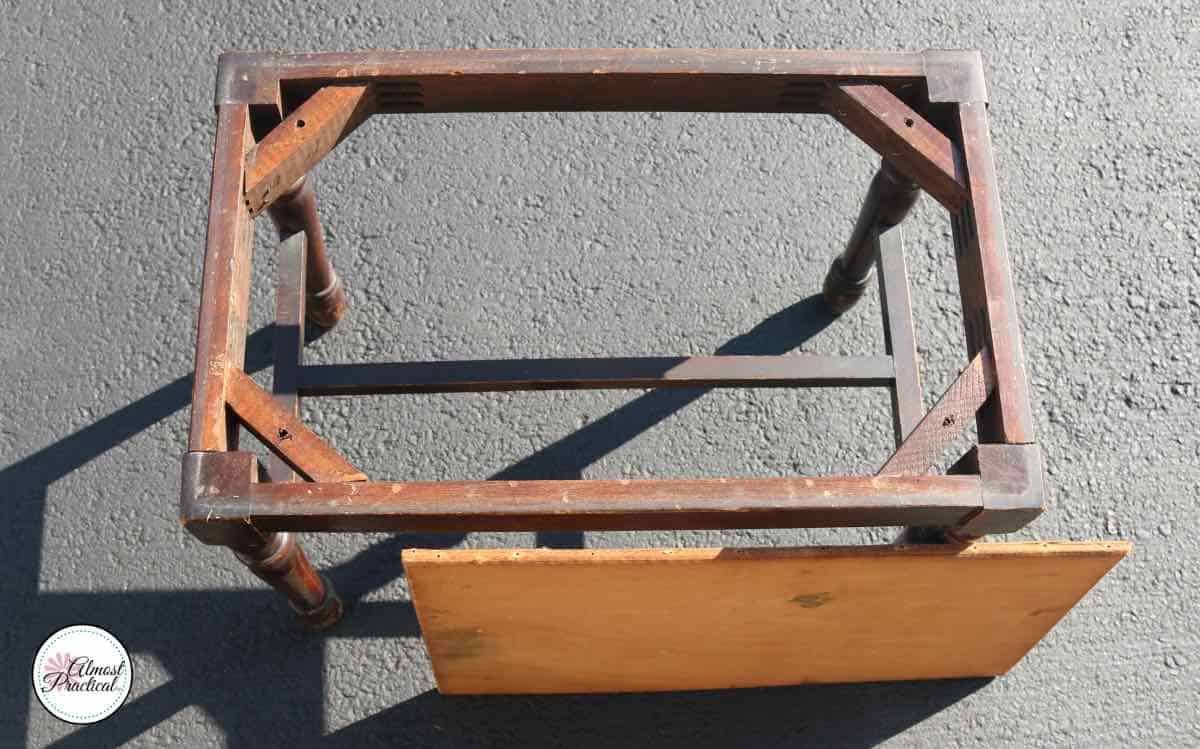
Wash the Bench Frame
After I removed the cushion and the sliders, I decided to wash the wooden base because there was years of dust and dirt built up on it.
I just filled a bucket with water and added a few drops of Dawn dishwashing liquid.
Then I sponged the bench off with the soapy water and followed by sponging the bench with rinse of plain water.
Since it was a sunny day, I let the bench frame dry outside in the warm afternoon for a few hours.
Strip and Sand the Bench Frame
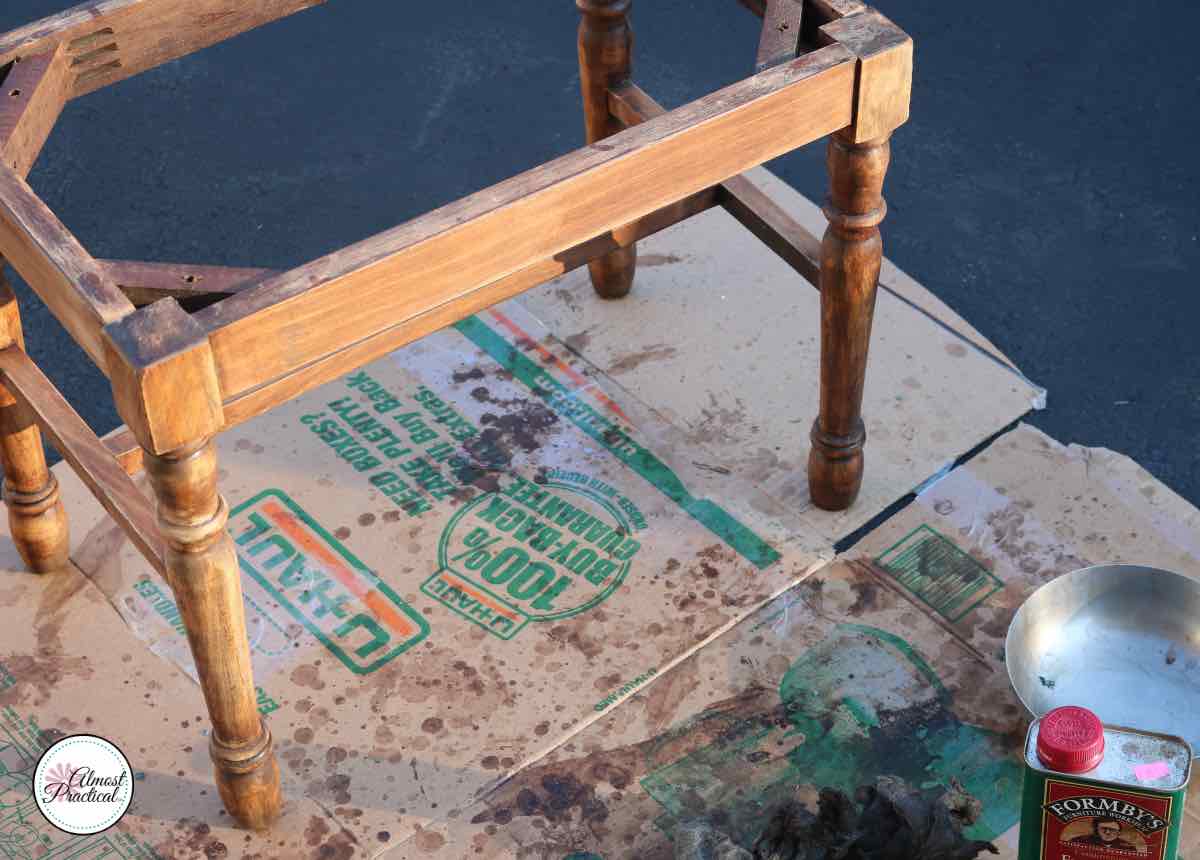
The next step to reupholster a bench is to strip the base of all the old varnish. This is the part that I hate the most.
I was actually hoping that a good sanding would remove the old stain, because the bench was so old.
But no such luck.
I used the Formby’s Furniture Refinisher and the steel wool to remove the old varnish. Luckily I still had some left over from when I refinished my kitchen table.
In fact, many of the supplies that I need to reupholster a bench are the same ones that I used for the kitchen table project.
One thing to note is make sure to get Refinishing gloves as opposed to nitrile gloves. I used nitrile gloves and they just dissolved in the Formby’s and made a big mess. I am assuming refinishing gloves will work much better, since they are designed for this exact purpose.
After I removed all of the old stain, I did my best to sand down the bench frame.
I must say that I am kind of impatient when it comes to sanding. And honestly, this project of reupholstering a bench was something that I just really wanted to be done with – so I could have probably done a much better job of sanding.
But it is what it is.
Stain and Poly the Bench Frame
After sanding, I dusted the bench off. You probably should use a tack cloth to get rid of any fine dust particles, but I just used a damp rag.
Next, I brushed on a thin coat of the Minwax Wood Stain.
You can do more than one coat depending on how dark you want the color to be. Just allow some drying time in between.
I used two coats to my bench. The wood was already dark from the old stain, so one coat would have been enough. But I felt that the coverage wasn’t very even, so I applied a second coat to smooth everything out.
Once the stain was dry (I waited a whole day), I applied three coats of Minwax Polyurethane to the bench over the course of several days.
And then it was time to reupholster a bench cushion.
I did mention that I have never done this before, didn’t I?
How to Reupholster a Bench Cushion
Since I really didn’t know what I was doing, I turned to the internet and followed this tutorial.
For the most part, it worked well – with one issue which I will get to.
So, basically I cut a piece of the upholstery foam to the size of the bench seat board, adding about 3 inches extra foam on all sides (The tutorial says one inch but I was afraid to cut the upholstery foam too small. I figured I could always trim it after.)
I also came across another tutorial on how to reupholster a bench (I don’t remember where) that used a layer of bonded Dacron upholstery batting on top of the upholstery foam. That tutorial mentioned that using the batting ultimately gave the fabric cover a nice smooth look, so I decided to use it as well.
For the bonded Dacron batting, I cut a piece that was a few inches bigger on all sides, than the piece of upholstery foam that I cut.
Finally, I cut a piece of upholstery fabric to be a few inches bigger all around than the bonded Dacron piece.
Attaching The Cushion Materials to the Bench Seat
Starting in the middle on one of the long sides of the wooden bench seat board, I used my handy new electric staple gun to staple the foam to the the board.
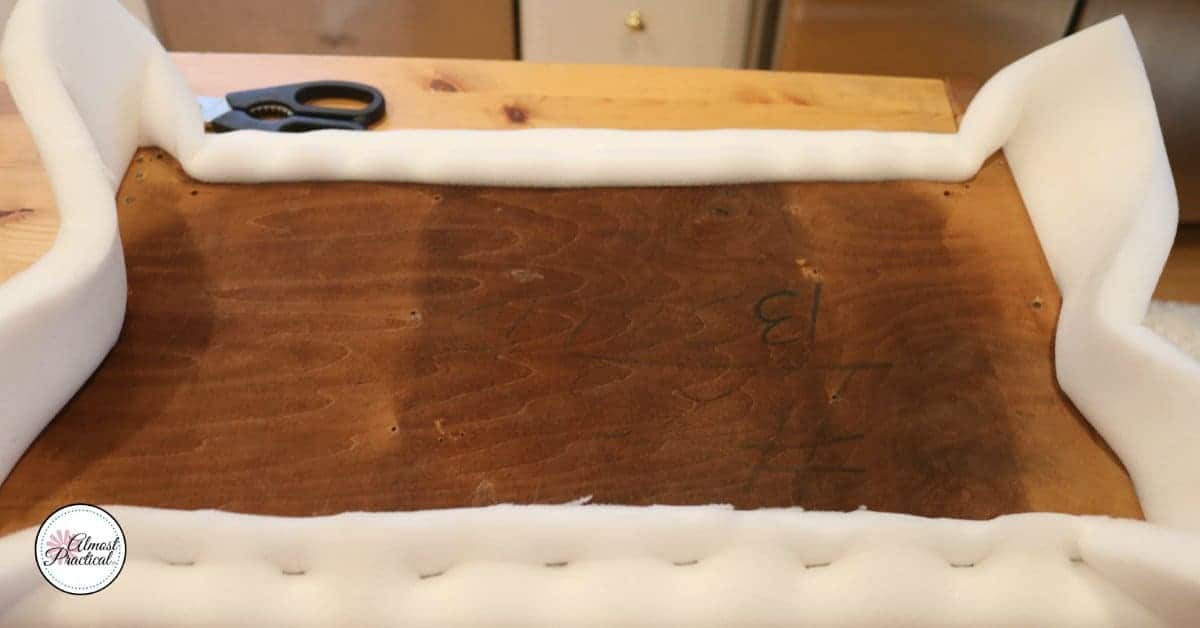
I pulled the foam tight across the board and placed one staple on the opposite long side, and then repeated the process with the short sides of the bench seat board.
Working my way from the center to the corners on each side, I placed a staple about every inch.
Yikes!
In researching this article I also found this video which uses an entirely different approach.
I am tempted to redo my bench cushion now that I have seen this:
What To Do With the Corners?
This is where I felt that the tutorial fell short, and I don’t really have a good answer for you.
The corners.
Those blasted corners.
When you reupholster a bench seat using 1 inch high density upholstery foam, you end up with a lot of foam in the corners where the two edges meet.
The above mentioned tutorial makes it look so easy – “just staple on the diagonal, fold it over and trim the excess”.
The reality is that you end up with a ton of chunky foam in the corner.
So, I fudged through and trimmed and stapled it down here and there.
But ….
Today I found this video – and, boy oh boy, do I wish I had seen it before refinished my bench (I may have to go back and redo the seat cushion):
Rinse and Repeat with the Batting
Then I had to repeat the process with the sheet of bonded Dacron batting.
Can you imagine the thickness of material in the corners now?
Rinse and Repeat with the Upholstery Fabric
The final step to reupholster a bench seat cushion it to cover it with the upholstery fabric of your choice.
I went with a plain gold/beige color fabric that I already owned. Although I wish I had picked something much prettier like these options from Magnolia Home.
Here is a great video that will help you choose a durable fabric for your bench:
The process of attaching the fabric is similar to that of the batting and the foam.
I purposely kept the fabric piece bigger than the foam and batting, so I could stretch it over both those layers on the underside of the bench and staple it directly into the bench seat board.
Attaching the Bench Seat to the Frame
The final step to reupholster a bench is to attach your newly covered bench seat to the frame.
The problem with the way I covered the bench seat is that there is a lot of material in each corner that covers the original holes.
So, I just sort of lined the seat up and used the old screws to reattach the seat.
However, now that I have discovered all of the amazing videos at the Fabric Farms Interiors YouTube Channel – I am seriously considering redoing the bench seat one last time.
Have You Tried to Reupholster a Bench?
Overall, I am happy with my first attempt to reupholster a bench.
I am a complete DIY amateur but regardless, the bench looks much better than it did before.
Refinishing the wood frame was a pain, but the results look nice.
And having watched the videos that I included in this post – I now realize that I could have used a different process for the bench seat.
This would make it much less bulky in those problematic corners.
Since this particular bench does not get much use, I may just leave it as is.
But in the interest of learning how to reupholster a bench the right way – I may go back and make a second attempt at recovering the seat.
If I do, I will post an update just for you.
And if you are not up for a project like this one – you can always find a great little bench for your foyer or entryway online.
Please Pin This for Me
In the meantime, if you like the new look – I would love it if you shared my DIY bench project on Pinterest!








Very classy bench, and thanks for including the other vids. i love your mahagony finish. TY also for the glove tips; i will not use nitrile gloves.
Thanks Cathy! Glad the info was helpful.